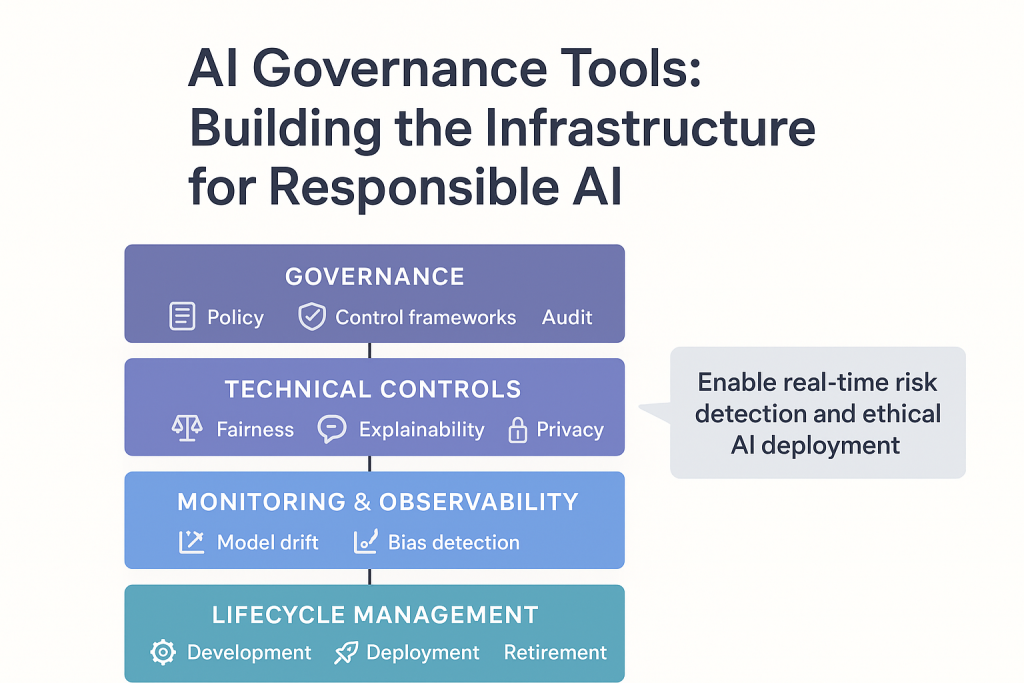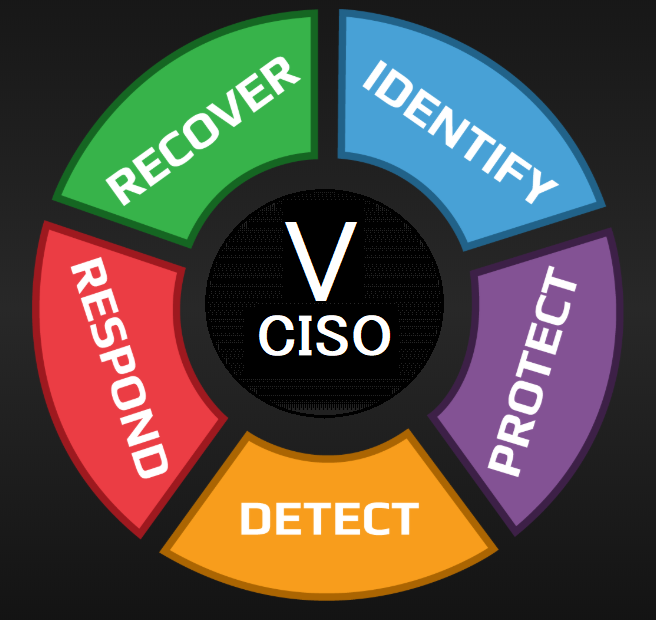
Essential Infrastructure for Responsible AI
The rapid adoption of artificial intelligence across industries has created an urgent need for structured governance frameworks. Organizations deploying AI systems face mounting pressure from regulators, customers, and stakeholders to demonstrate responsible AI practices. Yet many struggle with a fundamental question: how do you govern what you can’t measure, track, or assess?
This is where AI governance tools become indispensable. They transform abstract governance principles into actionable processes, converting compliance requirements into measurable outcomes. Without proper tooling, AI governance remains theoretical—a collection of policies gathering dust while AI systems operate in the shadows of your technology stack.
Why AI Governance Tools Are Necessary
1. Regulatory Compliance is No Longer Optional
The EU AI Act, ISO 42001, and emerging regulations worldwide demand documented evidence of AI governance. Organizations need systematic ways to identify AI systems, assess their risk levels, track compliance status, and maintain audit trails. Manual spreadsheets and ad-hoc processes simply don’t scale to meet these requirements.
2. Complexity Demands Structured Approaches
Modern organizations often have dozens or hundreds of AI systems across departments, vendors, and cloud platforms. Each system carries unique risks related to data quality, algorithmic bias, security vulnerabilities, and regulatory exposure. Governance tools provide the structure needed to manage this complexity systematically.
3. Accountability Requires Documentation
When AI systems cause harm or regulatory auditors come calling, organizations need evidence of their governance efforts. Tools that document risk assessments, policy acknowledgments, training completion, and vendor evaluations create the paper trail that demonstrates due diligence.
4. Continuous Monitoring vs. Point-in-Time Assessments
AI systems aren’t static—they evolve through model updates, data drift, and changing deployment contexts. Governance tools enable continuous monitoring rather than one-time assessments, catching issues before they become incidents.
DeuraInfoSec’s AI Governance Toolkit
At DeuraInfoSec, we’ve developed a comprehensive suite of AI governance tools based on our experience implementing ISO 42001 at ShareVault and consulting with organizations across financial services, healthcare, and B2B SaaS. Each tool addresses a specific governance need while integrating into a cohesive framework.
EU AI Act Risk Calculator
The EU AI Act’s risk-based approach requires organizations to classify their AI systems into prohibited, high-risk, limited-risk, or minimal-risk categories. Our EU AI Act Risk Calculator walks you through the classification logic embedded in the regulation, asking targeted questions about your AI system’s purpose, deployment context, and potential impacts. The tool generates a detailed risk classification report with specific regulatory obligations based on your system’s risk tier. This isn’t just academic—misclassifying a high-risk system as limited-risk could result in substantial penalties under the Act.
Access the EU AI Act Risk Calculator →
ISO 42001 Gap Assessment
ISO 42001 represents the first international standard specifically for AI management systems, building on ISO 27001’s information security controls with 47 additional AI-specific requirements. Our gap assessment tool evaluates your current state against all ISO 42001 controls, identifying which requirements you already meet, which need improvement, and which require implementation from scratch. The assessment generates a prioritized roadmap showing exactly what work stands between your current state and certification readiness. For organizations already ISO 27001 certified, this tool highlights the incremental effort required for ISO 42001 compliance.
Complete the ISO 42001 Gap Assessment →
AI Governance Assessment Tool
Not every organization needs immediate ISO 42001 certification or EU AI Act compliance, but every organization deploying AI needs basic governance. Our AI Governance Assessment Tool evaluates your current practices across eight critical dimensions: AI inventory management, risk assessment processes, model documentation, bias testing, security controls, incident response, vendor management, and stakeholder engagement. The tool benchmarks your maturity level and provides specific recommendations for improvement, whether you’re just starting your governance journey or optimizing an existing program.
Take the AI Governance Assessment →
AI System Inventory & Risk Assessment
You can’t govern AI systems you don’t know about. Shadow AI—systems deployed without IT or compliance knowledge—represents one of the biggest governance challenges organizations face. Our AI System Inventory & Risk Assessment tool provides a structured framework for cataloging AI systems across your organization, capturing essential metadata like business purpose, data sources, deployment environment, and stakeholder impacts. The tool then performs a multi-dimensional risk assessment covering data privacy risks, algorithmic bias potential, security vulnerabilities, operational dependencies, and regulatory exposure. This creates the foundation for all subsequent governance activities.
Build Your AI System Inventory →
AI Vendor Security Assessment
Most organizations don’t build AI systems from scratch—they procure them from vendors or integrate third-party AI capabilities into their products. This introduces vendor risk that traditional security assessments don’t fully address. Our AI Vendor Security Assessment Tool goes beyond standard security questionnaires to evaluate AI-specific concerns: model transparency, training data provenance, bias testing methodologies, model updating procedures, performance monitoring capabilities, and incident response protocols. The assessment generates a vendor risk score with specific remediation recommendations, helping you make informed decisions about vendor selection and contract negotiations.
GenAI Acceptable Use Policy Quiz
Policies without understanding are just words on paper. After deploying acceptable use policies for generative AI, organizations need to verify that employees actually understand the rules. Our GenAI Acceptable Use Policy Quiz tests employees’ comprehension of key policy concepts through scenario-based questions covering data classification, permitted use cases, prohibited activities, security requirements, and incident reporting. The quiz tracks completion rates and identifies knowledge gaps, enabling targeted training interventions. This transforms passive policy distribution into active policy understanding.
Test Policy Understanding with the Quiz →
AI Governance Internal Audit Checklist
ISO 42001 certification and mature AI governance programs require regular internal audits to verify that documented processes are actually being followed. Our AI Governance Internal Audit Checklist provides auditors with a comprehensive examination framework covering all key governance domains: leadership commitment, risk management processes, stakeholder communication, lifecycle management, performance monitoring, continuous improvement, and documentation standards. The checklist includes specific evidence requests and sample interview questions, enabling consistent audit execution across different business units or time periods.
Access the Internal Audit Checklist →
The Broader Perspective: Tools as Enablers, Not Solutions
After developing and deploying these tools across multiple organizations, I’ve developed strong opinions about AI governance tooling. Tools are absolutely necessary, but they’re insufficient on their own.
The most important insight: AI governance tools succeed or fail based on organizational culture, not technical sophistication. I’ve seen organizations with sophisticated governance platforms that generate reports nobody reads and dashboards nobody checks. I’ve also seen organizations with basic spreadsheets and homegrown tools that maintain robust governance because leadership cares and accountability is clear.
The best tools share three characteristics:
First, they reduce friction. Governance shouldn’t require heroic effort. If your risk assessment takes four hours to complete, people will skip it or rush through it. Tools should make doing the right thing easier than doing the wrong thing.
Second, they generate actionable outputs. Gap assessments that just say “you’re 60% compliant” are useless. Effective tools produce specific, prioritized recommendations: “Implement bias testing for the customer credit scoring model by Q2” rather than “improve AI fairness.”
Third, they integrate with existing workflows. Governance can’t be something people do separately from their real work. Tools should embed governance checkpoints into existing processes—procurement reviews, code deployment pipelines, product launch checklists—rather than creating parallel governance processes.
The AI governance tool landscape will mature significantly over the next few years. We’ll see better integration between disparate tools, more automated monitoring capabilities, and AI-powered governance assistants that help practitioners navigate complex regulatory requirements. But the fundamental principle won’t change: tools enable good governance practices, they don’t replace them.
Organizations should think about AI governance tools as infrastructure, like security monitoring or financial controls. You wouldn’t run a business without accounting software, but the software doesn’t make you profitable—it just makes it possible to track and manage your finances effectively. Similarly, AI governance tools don’t make your AI systems responsible or compliant, but they make it possible to systematically identify risks, track remediation, and demonstrate accountability.
The question isn’t whether to invest in AI governance tools, but which tools address your most pressing governance gaps. Start with the basics—inventory what AI you have, assess where your biggest risks lie, and build from there. The tools we’ve developed at DeuraInfoSec reflect the progression we’ve seen successful organizations follow: understand your landscape, identify gaps against relevant standards, implement core governance processes, and continuously monitor and improve.
The organizations that will thrive in the emerging AI regulatory environment won’t be those with the most sophisticated tools, but those that view governance as a strategic capability that enables innovation rather than constrains it. The right tools make that possible.
Ready to strengthen your AI governance program? Explore our tools and schedule a consultation to discuss your organization’s specific needs at DeuraInfoSec.com.
Stay ahead of the curve. For practical insights, proven strategies, and tools to strengthen your AI governance and continuous improvement efforts, check out our latest blog posts on AI, AI Governance, and AI Governance tools.
ISO/IEC 42001: The New Blueprint for Trustworthy and Responsible AI Governance
- A Simple 4-Step Path to ISO 42001 for SMBs
- How ISO 42001 Strengthens Alignment With the EU AI Act (Without Replacing Legal Compliance)
- When a $3K “cybersecurity gap assessment” reveals you don’t actually have cybersecurity to assess…
- ISO 42001 and the Business Imperative for AI Governance
- Emerging Tools & Frameworks for AI Governance & Security Testing
InfoSec services | ISMS Services | AIMS Services | InfoSec books | Follow our blog | DISC llc is listed on The vCISO Directory | ISO 27k Chat bot | Comprehensive vCISO Services | Security Risk Assessment Services | Mergers and Acquisition Security




